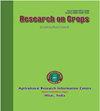Chemical desiccation of potato haulms to increase skin hardness and potato yield
Q3 Agricultural and Biological Sciences
引用次数: 0
Abstract
Desiccation of potato crops using herbicides is one of the methods widely used by farmers. Desiccation affects several key aspects such as tuber yield and potato skin hardness. This study aimed to investigate the effects of desiccation on potato (Solanum tuberosum L.) on skin hardness and yield. Experimental methods were used by varying the level of desiccation on different herbicide groups. Ammonium glufosinate, glyphosate, paraquat and saflufenacil herbicides were used in this study which were then compared with manual trimming and no desiccation treatment. The results showed that all herbicides reached a percentage of desiccation above 95% on the 15 days after application. All herbicide treatments other than glyphosate showed the same potato skin hardness as the manual trimming treatment and were harder than potato tubers without desiccation treatment. Desiccation using ammonium glufosinate herbicide at 375 g a.i./ha had the highest potato tuber yield compared to other herbicide applications.化学干燥马铃薯茎秆以提高表皮硬度和马铃薯产量
使用除草剂对马铃薯作物进行脱水处理是农民广泛使用的方法之一。脱水会影响几个关键方面,如块茎产量和马铃薯表皮硬度。本研究旨在调查干燥对马铃薯(Solanum tuberosum L.)表皮硬度和产量的影响。实验方法是改变不同除草剂组的干燥程度。本研究使用了草铵膦、草甘膦、百草枯和氟虫腈除草剂,然后与人工修剪和不干燥处理进行了比较。结果表明,所有除草剂在施用后 15 天的脱水率均超过 95%。除草甘膦外,所有除草剂处理的马铃薯表皮硬度与人工修剪处理相同,比未进行干燥处理的马铃薯块茎更硬。与其他除草剂相比,使用 375 克有效成分/公顷的草铵膦除草剂进行干燥处理的马铃薯块茎产量最高。
本文章由计算机程序翻译,如有差异,请以英文原文为准。
求助全文
约1分钟内获得全文
求助全文
来源期刊

Research on Crops
Agricultural and Biological Sciences-Soil Science
CiteScore
1.50
自引率
0.00%
发文量
93
审稿时长
1 months
期刊介绍:
The Research on Crops is a peer-reviewed journal publishing original research papers, review articles and short communications in English on all basic and applied aspects of crop sciences, agricultural water management, agro-climatology, agroforestry, agronomy, crop production, crop protection, cropping systems, food science & technology, genetics & plant breeding, horticulture, plant & soil science, plant biotechnology, plant nutrition, post-harvest management of crops, seed science, soil management & tillage, vegetables, weed science, agricultural engineering, agri-business, agricultural economics and extension, etc. The aim of the journal is to provide a forum for the scientific community to publish their latest research findings.
The manuscripts submitted for publication should not contain data older than 4 years on the date of submission.
The articles submitted for publication in this journal should not be submitted elsewhere simultaneously for publication in another journal. These should not carry any copyright material without prior permission of copyright holder.
The articles should present a complete picture of the investigation made and should not be split into parts.
There is no prescribed limit regarding the number of pages in case of full-length articles. However, the authors are advised to keep the length of their articles from 4 to 10 full printed pages of the journal.
The articles should be divided into the sub-sections: ABSTRACT, INTRODUCTION, MATERIALS AND METHODS, RESULTS AND DISCUSSION, CONCLUSIONS, and REFERENCES. Tables and figures should be appended separately at the end.
 求助内容:
求助内容: 应助结果提醒方式:
应助结果提醒方式:


